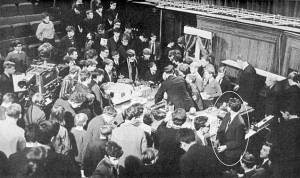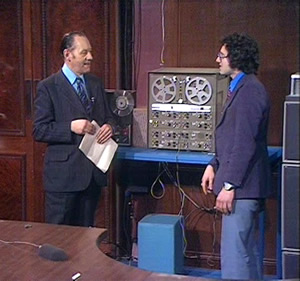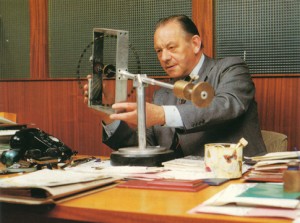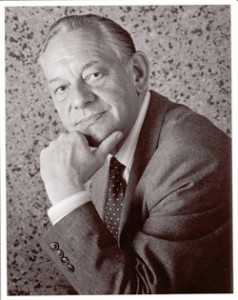For this second blog we’re going to look at an inventor, innovator and communicator of science on TV and in the classroom. Eric Laithwaite (1921-1997) came to Imperial College in 1964 as Professor of Heavy Electrical Engineering. His specialist work was on Linear Induction Motors. Prior to his arrival at Imperial, he had appeared on TV many times, so he was no novice to the whole process of making both TV programmes and, as was the case with ICI’s Millbank Films, science learning materials for schools. He made a whole series of films for ICI such as “Motors Big and Small”; “Shaping things to come” and “The Circle of Magnetism”.
He was also the first person to present an entire Royal Institution Christmas Lecture series on TV, that was on BBC2 in 1966. Since that time every RI Christmas lecture has been televised. Once again though he made history by being the only person to present a Christmas lecture a second time and that happened in 1974. It was, however, not simply a repeat of the one in 1966!

How do I know all this you may ask? Well, I’m biased because for a short period of time I worked with him and was present during the recordings of the 1966 Christmas lectures at the Royal Institution. If anyone still has his book from the series “The Engineer in Wonderland” you’ll see me in a photo on page 155.
By the time of the 1974 series “Engineer through the looking-glass” I had moved on to do video production. So I was surprised to receive a visit from Eric Laithwaite in the early summer of 1974. He wanted to chat about ideas for talking backwards. Programme number 3 was to be “Jam yesterday and jam tomorrow” and he wanted to see what we could come up with for the reversing of time and speech.

I must have come up with a good idea because when he heard what I’d done with “Merry Christmas and a Happy New Year” (backwards of course) he said “Right I’d like you to present that during the lecture”. My credit in his book of the series says “…Colin appeared ‘officially’ in the second lecture taking over part of the lecture in effect”. Because of media interest in the advanced publicity for the 1974 series both myself and Eric Laithwaite were interviewed on BBC Radio about the speaking backwards idea. It was only recently that I had the opportunity to get hold of a DVD copy of the original videotape still held in the BBC archives. The quality is still amazingly good too.
Armed with all of this background knowledge, in 1980 I recorded an archival interview (link above) with him in his lab office in Electrical Engineering. Part of this interview was used in a special IEEE memorial lecture given by his colleague Barry Owen.
Eric Laithwaite’s work continued with linear motors of all types. The ‘Magnetic River” was a short video (link above) I shot for him in March 1984. It features his now familiar model of a levitated and propelled train by means of magnetic induction and was the very last video I made with him. A few years earlier this same linear motor had appeared in the James Bond film “The Spy who loved me”. It was another of “Q’s” gadgets that was demonstrated to Bond. I just happened to be going to Pinewood Studios and took the demo film to Eon Productions for them to decide whether to use it or not in the production. They did use it and Eric Laithwaite’s technician Cliff Johnson was seen operating the Magnetic River in the actual Bond film. Buy the DVD of the film to see what I mean.
As well as its uses for tracked transport the ‘Mag River’ had other potential. In this 1980 example (link above) its use as a metal sorter, sorting out aluminium from other scrap materials, is being demonstrated. Materials were painted various colours to show what was being separated.
A video I shot with Eric Laithwaite in May 1983 (link above) was a demo for an American film company who were considering making the “Silver Surfer”. The idea was to levitate someone on a huge aluminium sheet. As you’ll see from this video, it was a rather daunting task and as far as I recall, never happened. All the humming is coming from the huge electromagnetic field coming from the coils.
His research in later years into Gyroscopes was, and still is, a topic of much discussion within the scientific community. Here, he demonstrates the principles of a gyro using a rather large and heavy wheel (link above). It’s spun up to speed with a normal household drill! We recorded this video in our TV Studio in May 1983 and needless to say, I stayed well back from both him and the wheel! It was always ‘fun’ working with Eric Laithwaite and I recall him sliding off a chair in the studio as he laughed so much when we tried speaking backwards into a taperecorder. He once said to me that when a job is no longer fun, it’s not worth continuing with it. The last time that I spoke with Eric Laithwaite was when he was telling me about the concept of a linear motor launcher for NASA rockets/vehicles, I never saw his again…

Colin Grimshaw December 2009

It was a very inspiring,motivating and knowledge gathering session coming to this post and reading about the life history and role played by Eric Laithwaite in the history of Science and technology.It is because of the commendable researches and inventions made by these genius scientist that we are having such a lavish and luxurious lifestyle.
Nice stuff. I’m going to recommend your site to a few friends of mine, signed up for your feed already.
A brilliant man and a great loss to science.
I understand Professor Eric Laithwaite’s Magnetic River motor gave propulsion, guidance and levitation “all” in one motor so why are these MagLev people messing about with their old fassioned idaes and passing them off as the latest high tec.?
Yes you’re correct. I ‘think’ the new idea is/was to push by Eric Laithwaite’s method but use wheels rather than a linear motor to float the vehicle? Open to other comments to correct me on this….
I remember a Laithwaite lecture for H.G Wells Soc., must have been about ’69 or ’70, which would have had Health and Safety apoplectic with rage. If my memory serves me correctly it included using a linear induction set of coils to fire a small spear across the front of the lecture theatre, ending up impaled in a block of wood strategically placed to receive it.
Hi Dave,
Yes, you are referring to what he called the ‘gun’. I might have some video or images of that…
Most things he did were a bit like you describe (risky). When I was involved with the 1966 RI Christmas lectures I was handed a live cable of one of the 415 volt phases to hold (it was of course a shielded cable, but the open end was live!)
I really hope that maglev sets its foot in the USA, because that would give a big boost to this technology.
Hello,
We are still showing electrical students the Circle of Magnetism Tape today. It is an essential part of their learning of magnetism. The tape is very worn and we would like to get a copy on DVD if possible. Is the series still available today?
Regards
Joe Quinnell
Electrotechnology Department
Goulburn Ovens Institute of TAFE
Shepparton
Victoria. 3630
Australia
Hi Joe and thanks for your feedback. I’ll be in touch with you via email as regards your request.
Colin Grimshaw
Hi,
I have been researching, trying to obtain a dvd copy of Eric Laithwaite’s “Circle of Magnetism”. We have a similar situation to Joe Quinnell in the blog above. Our lecturers are still wanting to use the programme but we only have the VHS copy. Is it possible to purchase a dvd copy? Alternatively, would we be able to make a legal copy ourselves?
Regards
Lori Myles
Library Technician
Central Institute of Technology
Perth Campus Library
Perth
Western Australia
Hi Lori,
I’ve only just picked your message up about the Eric Laithwaite video…sorry! I will contact you about this as soon as possible as I am myself currently in New South Wales visiting a friend.
Colin Grimshaw
Lori,
I have been unable to locate the whereabouts of the library containing the Circle of Magnetism. Originally it was the ICI Film Library, then it became (ICI) Millbank Films.
Can I suggest you contact the British Universities Film and Video Council for help?
http://bufvc.ac.uk/contactus
I was one of eric laithwaites sceintific engineering children in the sixties and i have dedicated my life to the subjects he studied. i have made remarkable breakthroughs in the field of gravitatioal propulsion and I would like to be put in contact with someone who worked with him? thankyou.
Richard,
Sadly, I have a feeling that no one is left from the era of Eric Laithwaite who would have worked with him, at least not still at Imperial. As you may know, he moved his research work to Sussex University just prior to his death, so maybe look there? I’ll see what I can find out for you as far as Imperial is concerned.
Can you explain why the experiments and demonstrations that Professor Laithwaite did are considered to not be true anti-gravity?
Thank You.
Personally I cannot. But here’s a starting point for more information:
http://www.rigb.org/2013/december/eric-laithwaite
I had never heard of professor Eric Laithwaite, although he did look familiar. A co-worker had posted the video demonstration of a large gyro wheel on face book, and after seeing it immediately I had ideas flooded my head. I grabbed a pen and paper, and started writing down all of the different ideals that came to me, that was six months ago. I only saw this website today for the first time, and saw some of the same ideas I had wrote down…WOW!
Im not an Engineer or a Mathematician.
I guess the super consciousness is at work.
You should also see the Christmas Lecture called “It’s my invention” !!
http://www.richannel.org/christmas-lectures-1974-eric-laithwaite–its-my-own-invention
See new post: Engineering the Hovertrain
http://wp.me/pBnO8-1B0
Colin
I was an undergraduate student of Eric’s between 1975 and 1978 and we met many times. Eric persuaded me to take up engineering, rather than business, and invited me to the Christmas lectures (as well as the infamous RI lecture on gyroscopes).
In 1978 I presented a student paper on linear motors at the IEE, and was well aware of the trials and tribulations of Eric and Tracked hovercraft through a family connection.
I still have (and treasure) all his books.
Interestingly, I now have a faculty position at Lassonde School of Engineering in Toronto, where I am Professor of Entrepreneurial Engineering, combining my passion for technology and entrepreneurship.
Andrew Maxwell
PS Do you know where I can find the clip of the linear motor (used with the tea tray) in the Bond movie
Hi Andrew and many thanks for your feedback. It’s nice to hear from someone who worked and knew Eric Laithwaite. If you went to all of the Christmas lecture you would have seen my ‘little effort’ in lecture 3 “jam yesterday, jam tomorrow”. The bond film featuring the magnetic river, and operated by Cliff Johnson, was THE SPY WHO LOVED ME.
Colin Grimshaw
Fascinating post Colin, thanks.
Laithwaite was an inspiration to me back in the 80s.
A true innovator.
During my time in Imperial, I went to a presentation by Eric Laithwaite,…on Moths!
It was interesting and amusing.
I think his treatment by the ‘establishment’ regarding his lecture on Gyros was utterly despicable. Probably more from jealousy than any real reason. The claim? ”He mentioned ‘Anti Gravity’!” Well he didn’t. what he said was, ‘It appears to defy gravity.’
He was effectively ostracised by the establishment, and his lecture expunged from the records.
Thats about the same level as Hitler’s book burning, and as mindless.
Dear Colin
I have been watching Prof Laithwaite’s videos.
He was marvellous, successfully conveying his subject, in an inspiring and educative manner.
The film Shaping Things To Come – 1972, features a teapot at 1 minute.
Do you know who designed/made this teapot and whether this model or something similar is still available/made today?
Ergonomic teapot – designed in 1971
https://www.youtube.com/watch?v=f5mA4l6xmGs
This contemporary teapot attempts to achieve the same as that featured, but I prefer the one in Prof Laithwaite’s video.
https://coff-hey.com/products/kinto-ridge-teapot-450ml-stainless-steel-handle-with-strainer?variant=34066980306988¤cy=GBP&utm_medium=product_sync&utm_source=google&utm_content=sag_organic&utm_campaign=sag_organic&utm_campaign=gs-2020-04-05&utm_source=google&utm_medium=smart_campaign&gclid=EAIaIQobChMI0tbx44aj6gIVCc-yCh1jLgxqEAQYAiABEgLdofD_BwE
Kind regards
Selma
Teapot and cover, part of the ‘Drop’ shaped tea set, glazed porcelain, designed by Luigi Colani, manufactured by Rosenthal, Germany, 1971.
Colani, Luigi, born 1928 (designer)
Rosenthal AG (manufacturer)
https://collections.vam.ac.uk/item/O170654/drop-teapot-and-cover-colani-luigi/
Colin Grimshaw,
Good afternoon Colin, thank you for maintaining Prof. Laithwaite’s legacy. It’s hard to believe, just getting finished watching him on Yutube, that if he were alive today, he’d be 102 years old.
I’m amazed every-time, like it’s the 1st time I watch Eric Laithwaite’s Lectures and demonstrations. I find it very odd and somewhat insulting when researching levitation, the Prof’s name is barely mentioned and, in the comments and videos on yutube, people have no clue who I’m talking about.
After scolding them for not giving recognition to the inventor, listening to them talking & trying to pass off a LIM (maglev) toy, as if they thought it up!?
Even searching the data bases to find a paper or patent is darn near impossible! I’ve tried searching for the Prof’s assistants’ as well and had some luck, how little it may be. (Fed Eastman, Barry Owen)
I’m Looking for anything at all, if you have, any information on the “Two-Coil” aluminum disk, levitation device. It’s is in the opening of his lecture “The Forces of Induction” (1969.)
Like I mentioned I’ve watched countless videos and looked up a mass of journal paper’s/patents and know, not One person have I seen use his Technology for levitating a ball or disk like him.
I guess it’s a testimony to the rigors of an EE, I would grateful for any info you may have. THanks ..
– James –